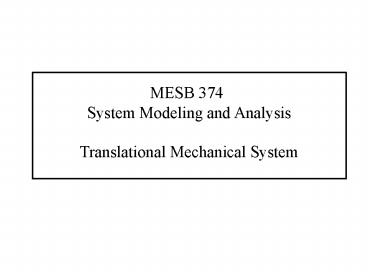ME375 Dynamic System Modeling and Control - PowerPoint PPT Presentation
1 / 22
Title:
ME375 Dynamic System Modeling and Control
Description:
Understand System Function, Define Problem, and ... Suspension System ... Suspension System. MDOF Suspension. Simplified Schematic (with tire model) Assume ref. ... – PowerPoint PPT presentation
Number of Views:80
Avg rating:3.0/5.0
Title: ME375 Dynamic System Modeling and Control
1
MESB 374 System Modeling and AnalysisTranslati
onal Mechanical System
2
Translational Mechanical Systems
- Basic (Idealized) Modeling Elements
- Interconnection Relationships -Physical Laws
- Derive Equation of Motion (EOM) - SDOF
- Energy Transfer
- Series and Parallel Connections
- Derive Equation of Motion (EOM) - MDOF
3
Key Concepts to Remember
- Three primary elements of interest
- Mass ( inertia ) M
- Stiffness ( spring ) K
- Dissipation ( damper ) B
- Usually we deal with equivalent M, K, B
- Distributed mass ? lumped mass
- Lumped parameters
- Mass maintains motion
- Stiffness restores motion
- Damping eliminates motion
(Kinetic Energy)
(Potential Energy)
(Eliminate Energy ? )
(Absorb Energy )
4
Variables
- x displacement m
- v velocity m/sec
- a acceleration m/sec2
- f force N
- p power Nm/sec
- w work ( energy ) Nm
- 1 Nm 1 J (Joule)
5
Basic (Idealized) Modeling Elements
- Spring
- Stiffness Element
- Reality
- 1/3 of the spring mass may be considered into the
lumped model. - In large displacement operation springs are
nonlinear.
Linear spring ? nonlinear spring ? broken spring
!!
- Idealization
- Massless
- No Damping
- Linear
- Stores Energy
Hard Spring
Potential Energy
Soft Spring
6
Basic (Idealized) Modeling Elements
- Damper
- Friction Element
- Mass
- Inertia Element
- Dissipate Energy
fD
- Stores Kinetic Energy
7
Interconnection Laws
- Newtons Second Law
Lumped Model of a Flexible Beam
- Newtons Third Law
- Action Reaction Forces
Massless spring
E.O.M.
8
Modeling Steps
- Understand System Function, Define Problem, and
Identify Input/Output Variables - Draw Simplified Schematics Using Basic Elements
- Develop Mathematical Model (Diff. Eq.)
- Identify reference point and positive direction.
- Draw Free-Body-Diagram (FBD) for each basic
element. - Write Elemental Equations as well as
Interconnecting Equations by applying physical
laws. (Check eq unk) - Combine Equations by eliminating intermediate
variables. - Validate Model by Comparing Simulation Results
with Physical Measurements
9
Vertical Single Degree of Freedom (SDOF) System
g
- Define Problem
The motion of the object
- Input
- Output
- Develop Mathematical Model (Diff. Eq.)
- Identify reference point and positive direction.
- Draw Free-Body-Diagram (FBD)
- Write Elemental Equations
From the undeformed position
From the deformed (static equilibrium) position
- Validate Model by Comparing Simulation Results
with Physical Measurement
10
Energy Distribution
- EOM of a simple Mass-Spring-Damper System
- We want to look at the energy distribution of
the system. How should we start ? - Multiply the above equation by the velocity term
v Ü What have we done ? - Integrate the second equation w.r.t. time
Ü What are we doing now ?
f
Change of kinetic energy
Change of potential energy
Energy dissipated by damper
11
Example -- SDOF Suspension (Example)
- Simplified Schematic (neglecting tire model)
- Suspension System
- Minimize the effect of the surface roughness of
the road on the drivers comfort.
From the absolute zero
From the path
From nominal position
g
M
x
K
B
x
x
p
12
Series Connection
- Springs in Series
fS
13
Series Connection
- Dampers in Series
Û
fD
fD
BEQ
B1
B2
14
Parallel Connection
- Springs in Parallel
fS
fS
Û
15
Parallel Connection
- Dampers in Parallel
Û
16
Horizontal Two Degree of Freedom (TDOF) System
- DOF 2
- Absolute coordinates
- FBD
K
K
- Newtons law
17
Horizontal Two Degree of Freedom (TDOF) System
Static coupling
- Absolute coordinates
- Relative coordinates
Dynamic coupling
18
Two DOF System Matrix Form of EOM
K
K
Input vector
- Absolute coordinates
Output vector
Mass matrix
Damping matrix
SYMMETRIC
- Relative coordinates
Stiffness matrix
NON-SYMMETRIC
19
MDOF Suspension
- Simplified Schematic (with tire model)
- Suspension System
TRY THIS
x
p
20
MDOF Suspension
- Simplified Schematic (with tire model)
- Suspension System
Assume ref. is when springs are Deflected by
weights
Car body
Suspension
Wheel
Tire
Road
Reference
21
Example -- MDOF Suspension
- Draw FBD
- Apply Interconnection Laws
22
Example -- MDOF Suspension
- Matrix Form
Mass matrix
Damping matrix
Stiffness matrix
Input Vector































